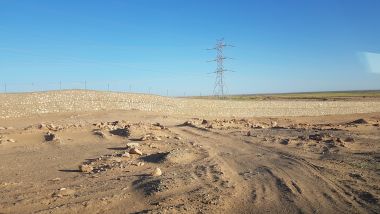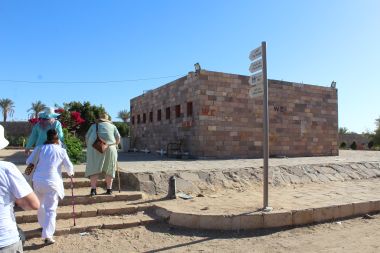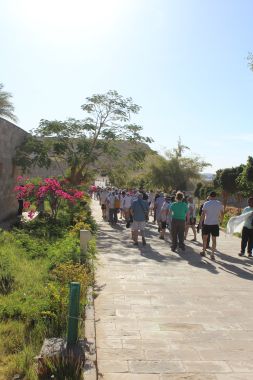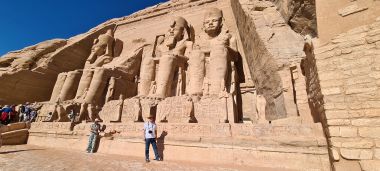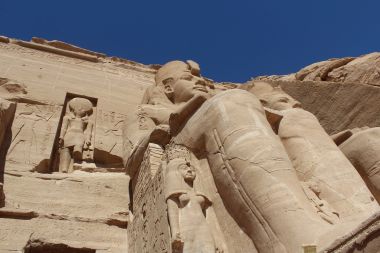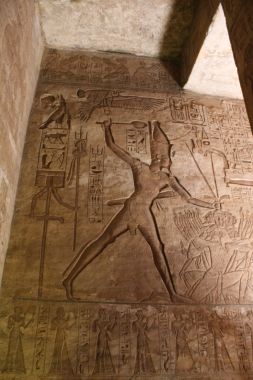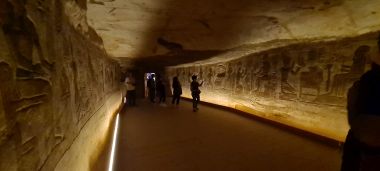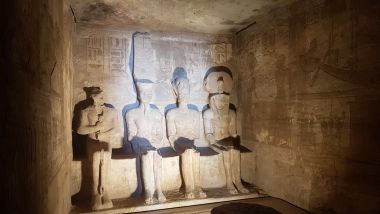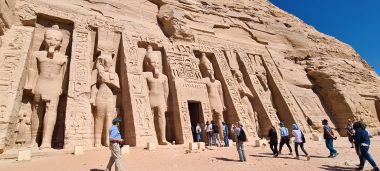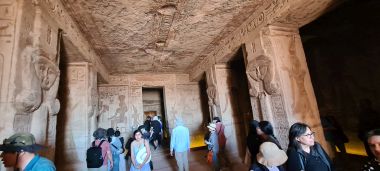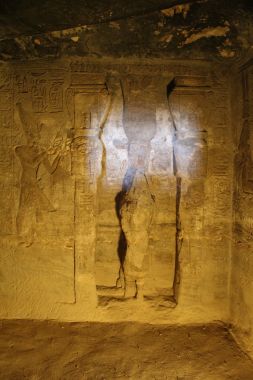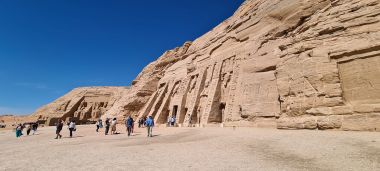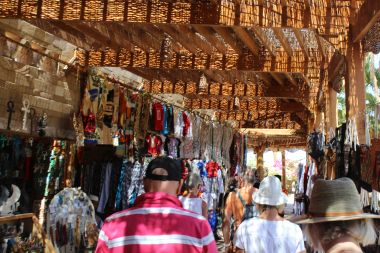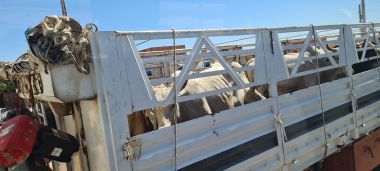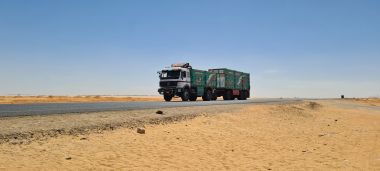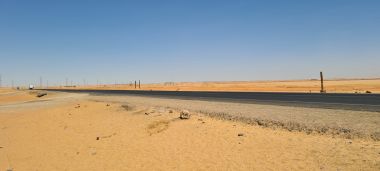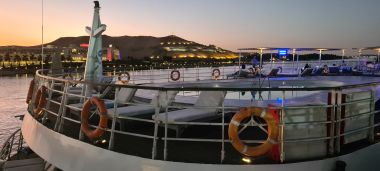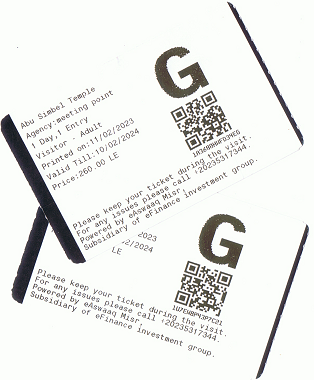Day 5 - Abu Simbel - March 13, 2023
I really do hate early mornings but I think on this trip it is the price you pay for some incredible memories. We were up at about 3 am then went to the lounge where coffee, tea and cakes were waiting for us though, sadly, no other drinks so I had to make do with cake. In the lobby they had arranged brown “Sultan Hussan” fabric bags containing our breakfast along the window sills which we helped ourselves to. Everyone on the boat was leaving early with the Germans departing just before we did at 4:30. Majid took us out the boat into the dark of the early morning, up the stairs to the park then up the final set of stairs to the road to get on the coach which was already filled with the passengers from the Odyssey. We were lucky and found two seats on the right side (always the right side, better to see things when driving on the right side of the road) near the front of the coach. Everyone promptly got settled and attempted to get some sleep. I have a hard time sleeping on coaches so it took me a while before I pulled my ever-present hat (to keep off the sun!) over my eyes.
The coach wound it's way through the quiet streets of the city as it had yesterday on our way to the Aswan dam but instead of turning left at the roundabout into the dam complex we turned right directly into the desert. And that is pretty much about it for next few hours with the desert on either side of the narrow strip of tarmac we were following to Abu Simbel. The road is actually quite good as it is part of an Egyptian government plan to reclaim the desert, building homes for it's many millions of inhabitants. The lights on the coach were out and it was quite quiet. At approximately 5:30 the sun rose but not many people were awake to appreciate it.
A short time later Mel and I were going through our breakfast bags - Two (local processed) cheese half sandwiches, two (cured) meat half sandwiches, a croissant, an orange, a banana, a small drink box and a packet of crisps. There was also some absolutely awful local jam that is basically not much more than jellied sugar though they did have a packet of rather nice honey. Having learned from our last coach trip I had manged to take some packets of butter from the buffet yesterday to use instead. We ate everything except the orange and crisps which we saved for later in the day as we knew they would not go off.
On the right side of the coach we followed a 20 foot tall concrete and stone wall for many miles. Majid says this is part of the military's dessert reclamation project and we could see the occasional round patches of greenery where irrigation has started (round because of the irrigation machine's sweeping arm). On the left side of the road there was construction and a number of trucks which we were told are for mining of gold and phosphor. There was the occasional truck stop with large numbers of tourist buses and lorries parked outside. At the “Tropic of Cancer” we passed over a huge aqueduct stretching into the distance on either side with a massive number of white egrets before shortly turning left where Majid told us we were only 1/2 mile from the border with Sudan on the road continuing straight. It was still another hour to Abu Simbel.
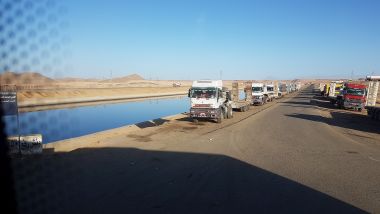
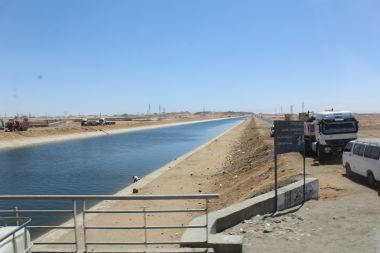
As our group woke up and we approached our destination Majid started talking a bit more, explaining that Abu Simbel was another Nubian village and that they do not often mix with other races. The question was why the magnificent Abu Simbel temple was built in this area in the extreme south of the country and the answer was due to love. Ramses II had many children with many wives but had a “Queen Consort”, Nefertari, who he loved above all of them. She was African, a Nubian, from Abu Simbel and so he promised her that he would build a temple to her here though she died before it was completed.
We passed through the otherwise normal town of Abu Simbel to pull into the temple complex. When the Aswan Dam was built this was another temple that needed to be moved to be protected from the ever rising waters of Lake Nassar. UNESCO was involved in funding the operation which required the moving of not only the two temples making up the site and their rooms covered with elaborate paintings but also the surrounding rock face to preserve the context, and look, of the temples. All told the site was carved into 250 pieces to facilitate the move. The whole operation resulted in raising the temples 65 meters. As we approached we could see two massive concrete mounds which are the back of the relocated temples located on the edge of the lake just outside of the town.
The coach pulled into the car park and we staggered out into the sunshine with many making way immediately to the toilets (we were told these toilets rather than the ones closer to the entrance are better - As with all toilets here, you pay a small amount of money to the attendant – official or no). We gathered outside the toilets waiting for the group to gather and clapped when one of our group took a bit longer than the rest in use of the facilities - Much to his good-natured embarrassment.
We had been given our entrance tickets on the bus before we arrived so were able to quickly pass through the entrance building and security to again gather on the far side, waiting on the stone path leading to the left and right of the two huge concrete mounds.
To our right the waters of the lake were clear to see. A few of our group would have had trouble with the steep, winding walk to the front of the temples so Majid took a few minutes to arrange a golf buggy for them before gathering the rest of us up and taking us along the path to the right.
The Abu Simbel temples are what many people might think of when they think of Egypt: The four massive statues of a seated Ramses II carved into the face of the rock. The left most statue is a young Ramses II, the second statue is broken as a result of an earthquake (even this destruction was painfully recreated when the temple was moved), and the rightmost two statues showing the aging pharaoh. This is the “Great Temple of Ramses II” (or “Temple of Amon Re and Ra-Harakhte”).
To the right of this temple there is the Small Temple of Hathor and Nefertari, the true love of his life which has a smaller façade comprised of six more statues.
We assembled near the seating for the evening light show near the banks of the lake while Majid gave us some more information while we baked in the hot sun. He showed us some interesting pictures of what the site looked like when it was flooded before the UNESCO project (the pictures are part of a set that he was also offering for sale) and explained what we would see inside the temples. Tour guides are not allowed inside the cramped spaces of the temples. Controversially Ramses II considered himself an equal to the Gods with many depictions showing him at the same height as the other Gods, heck, the sight of the four massive statues outside his temple is enough to convince most that he had a pretty big ego.
After the talk we were told when we needed to be back at the coach and were left to explore the site on our own. A few minutes later there was a bizarre accident as an older member of our group tripped on the uneven rocks of the site and fell face down into the stones resulting in a lot of blood and Majid quickly coming over to assist.
We were interested in appreciating the impressive scale of the site so we got as close as we could to the base of the statues of the great temple, looking up into the face of Ramses II. It is really something to actually be there, to be within an arms reach of such an amazing artefact. The carving even on the weathered exterior is wonderful intricate and done with such precision you can make out the (small) wrinkles on the faces and bulge of the kneecaps. It is hard to believe these temples are almost 3,300 years old.
The tall entrance temple is between the second and third colossi (there is a door here and if you want to pay some money you can turn a great gold key in the door) with even the walls on either side of this door elaborately carved with hieroglyphics. The first room has eight more statues of Ramses II, four on either side with the surrounding walls and ceilings featuring painted and carved scenes.
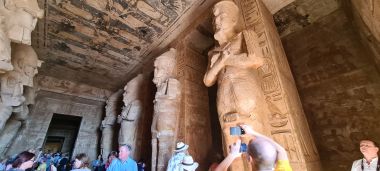
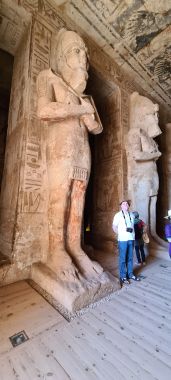
In every direction there was something to see, provided, of course, a tourist was not standing in front of it (a point that annoyed several who were trying to take pictures - how rude of people to stumble around in awe and block their shot!). Much like other sites we were again impressed here with the vivid colours and perfection of the carving on display. Considering it's age it looks pretty good. It was also helpful that the dim interior of the temple was artificially lit so we were able to appreciate it.
Even the numerous low-ceilinged side storage chambers were carved along their length. Most of the scenes depicted in the great temple are, of course, of how great Ramses II was, vanquishing his foes and being worshipped by his people. To prevent accidents there was a wooden walkway throughout the temple which is just as well as most people were walking around in somewhat of a daze staring at what was around them.
The inner sanctuary has what many ancient Egyptians may have considered the ultimate sacrilege, statues of Ptah, Horakhty, Ramses II, and Amun. How DARE he consider himself the equivalent of a God?
Suitably impressed, we made our way out of the great temple and over to the smaller temple. Outside there are two statues of Ramesses flanking one of Nefertari dressed as Hathor and the others smaller statues of their children.
This temple, no great surprise, was no where near as impressive and despite what Ramses II said about his appreciation of his beloved queen consort he features an awful lot on much of the interior with any picture of his love matched in size and nature with one of himself. The first chamber has six carved square pillars of Nefertari with elaborate coloured carvings, again, decorating all walls and the ceilings.
This is a much smaller temple with only a single statue at the high altar at the far end and only two small side storage niches.
Leaving the dim interior of the small temple we returned to the heat and bright sunshine to once again take in the impressive site, taking pictures of both temples from ever increasing distances back.
I took a quick look at the souvenir shop near the water but was disappointed to find very little written material about Abu Simbel itself but, instead lots of King Tut material which is odd considering he was no where near here. We also had a look at the deep blue waters of Lake Nassar that surround the site with islands, formerly hills, scattered about.
To return to the coach we took the path off to the right rather than retrace our steps. This was the long way round but it was a lot less busy and had the advantage of a bit of shade (it is not really hot but the sun is quite punishing). The back of the temples is basically two big mounts of dirt and concrete with the occasional path along their surface (though with lots of “keep out” signs). We only had 15 minutes before the coach was due to leave at 10:30 so we were now in a bit of a hurry as we returned to the main entrance and past it's café. There were four sets of stalls selling souvenirs that we had to pass through - with ever decreasing pleas for us to buy one thing or another - before arriving at the car park café then directed to the coach.
Abu Simbel Pictures (from Flickr)
By now we were pretty awake and were in search of something to eat since we did not have enough time to grab anything from the café (and it was expensive anyway) so we picked up a couple of tins of coke from the bus driver at 20 LE each though he did not have change for our 200 LE bill. As we left Abu Simbel the village was also wide awake with all sorts of traffic - animal and mechanical - on the streets. It really is just a typical Egyptian town to our eyes. Excitement on the bus was caused when a truck carrying a load of cattle in the back passed by.
Back again in the desert we snacked on the crisps from our breakfast (cheese flavour, very small bag) and our cold cokes. Around noon we stopped at a coach stop in the middle of no where to make use of the facilities and stretch our feet.
It was amazing to see the sands stretching into the distance and we were able to see the shimmering mirage in the distance generated by the heat.
More importantly, we were able to get some change from the toilet attendant for our cokes though we then bought some more crisps from the shop anyway (then picked up two more cokes on board!)…We were able to settle up with the driver and set about putting together a tip for Majid as this is the last time he would be our guide.
Back on the road we talked to the others from our boat we agreed 400 LE was a good amount and another 100 LE for the driver so we put that together and settled down for the return to Aswan. As with the rest of the trip I have been glued to the window just taking it all in. I poked Mel a few times to point out dust devils spinning against a rocky escarpment in the distance. There are dark black mounds we are told are made up of the local stone that is mined. A minor drama unfolded on the coach, we later learned, the gentleman sitting opposite us evidently threw up everywhere. Not a great way to end the trip.
In Aswan we first dropped most of our group off at the Odyssey where Majid also left. We were able to give him his tip and ask for his advice on visiting the souk which we hoped to do: Do not open your wallet; Do not allow yourselves to be guided as they will want money or take you to places you do not want to go. The traffic was awful but a short time later we were dropped at our dock. We were a bit late for lunch which had been at 1:30 pm (it was now after 2:30) but the crew helpfully reopened the dining room to allow us to eat. Just as well, it had been more than 10 hours since we had set out! Our fellow German passengers joined us a few minutes later.
The afternoon was spent chatting to our fellow English passengers on the roof, reading, dozing and Mel had a massage session from our onboard masseuse. Generally, we were relaxing after what was a very long morning. At 6 pm the sun went down and at 7:30 pm we headed down one floor for dinner. A short visit back up onto the deck was all we could manage before returning to our room.
This is our last night in Aswan as tomorrow we start our return trip to Luxor.
⇒ Continue to Day 6 - Aswan Souk and Cruising - March 14, 2023
